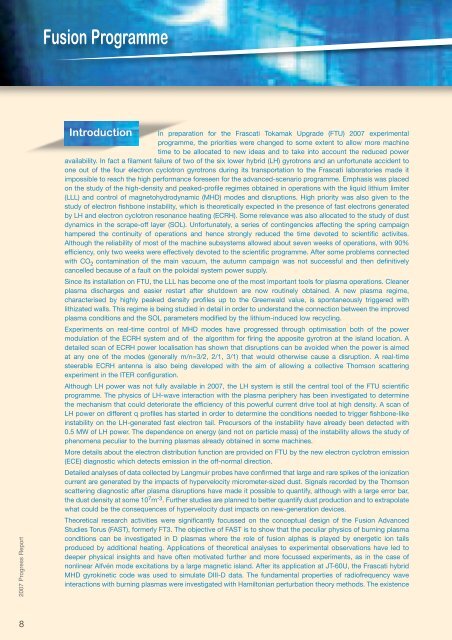Fusion Programme - ENEA - Fusione
Fusion Programme - ENEA - Fusione
Fusion Programme - ENEA - Fusione
- No tags were found...
You also want an ePaper? Increase the reach of your titles
YUMPU automatically turns print PDFs into web optimized ePapers that Google loves.
<strong>Fusion</strong> <strong>Programme</strong>2007 Progress ReportIntroductionIn preparation for the Frascati Tokamak Upgrade (FTU) 2007 experimentalprogramme, the priorities were changed to some extent to allow more machinetime to be allocated to new ideas and to take into account the reduced poweravailability. In fact a filament failure of two of the six lower hybrid (LH) gyrotrons and an unfortunate accident toone out of the four electron cyclotron gyrotrons during its transportation to the Frascati laboratories made itimpossible to reach the high performance foreseen for the advanced-scenario programme. Emphasis was placedon the study of the high-density and peaked-profile regimes obtained in operations with the liquid lithium limiter(LLL) and control of magnetohydrodynamic (MHD) modes and disruptions. High priority was also given to thestudy of electron fishbone instability, which is theoretically expected in the presence of fast electrons generatedby LH and electron cyclotron resonance heating (ECRH). Some relevance was also allocated to the study of dustdynamics in the scrape-off layer (SOL). Unfortunately, a series of contingencies affecting the spring campaignhampered the continuity of operations and hence strongly reduced the time devoted to scientific activites.Although the reliability of most of the machine subsystems allowed about seven weeks of operations, with 90%efficiency, only two weeks were effectively devoted to the scientific programme. After some problems connectedwith CO 2 contamination of the main vacuum, the autumn campaign was not successful and then definitivelycancelled because of a fault on the poloidal system power supply.Since its installation on FTU, the LLL has become one of the most important tools for plasma operations. Cleanerplasma discharges and easier restart after shutdown are now routinely obtained. A new plasma regime,characterised by highly peaked density profiles up to the Greenwald value, is spontaneously triggered withlithizated walls. This regime is being studied in detail in order to understand the connection between the improvedplasma conditions and the SOL parameters modified by the lithium-induced low recycling.Experiments on real-time control of MHD modes have progressed through optimisation both of the powermodulation of the ECRH system and of the algorithm for firing the apposite gyrotron at the island location. Adetailed scan of ECRH power localisation has shown that disruptions can be avoided when the power is aimedat any one of the modes (generally m/n=3/2, 2/1, 3/1) that would otherwise cause a disruption. A real-timesteerable ECRH antenna is also being developed with the aim of allowing a collective Thomson scatteringexperiment in the ITER configuration.Although LH power was not fully available in 2007, the LH system is still the central tool of the FTU scientificprogramme. The physics of LH-wave interaction with the plasma periphery has been investigated to determinethe mechanism that could deteriorate the efficiency of this powerful current drive tool at high density. A scan ofLH power on different q profiles has started in order to determine the conditions needed to trigger fishbone-likeinstability on the LH-generated fast electron tail. Precursors of the instability have already been detected with0.5 MW of LH power. The dependence on energy (and not on particle mass) of the instability allows the study ofphenomena peculiar to the burning plasmas already obtained in some machines.More details about the electron distribution function are provided on FTU by the new electron cyclotron emission(ECE) diagnostic which detects emission in the off-normal direction.Detailed analyses of data collected by Langmuir probes have confirmed that large and rare spikes of the ionizationcurrent are generated by the impacts of hypervelocity micrometer-sized dust. Signals recorded by the Thomsonscattering diagnostic after plasma disruptions have made it possible to quantify, although with a large error bar,the dust density at some 10 7 m -3 . Further studies are planned to better quantify dust production and to extrapolatewhat could be the consequences of hypervelocity dust impacts on new-generation devices.Theoretical research activities were significantly focussed on the conceptual design of the <strong>Fusion</strong> AdvancedStudies Torus (FAST), formerly FT3. The objective of FAST is to show that the peculiar physics of burning plasmaconditions can be investigated in D plasmas where the role of fusion alphas is played by energetic ion tailsproduced by additional heating. Applications of theoretical analyses to experimental observations have led todeeper physical insights and have often motivated further and more focussed experiments, as in the case ofnonlinear Alfvén mode excitations by a large magnetic island. After its application at JT-60U, the Frascati hybridMHD gyrokinetic code was used to simulate DIII-D data. The fundamental properties of radiofrequency waveinteractions with burning plasmas were investigated with Hamiltonian perturbation theory methods. The existence8













